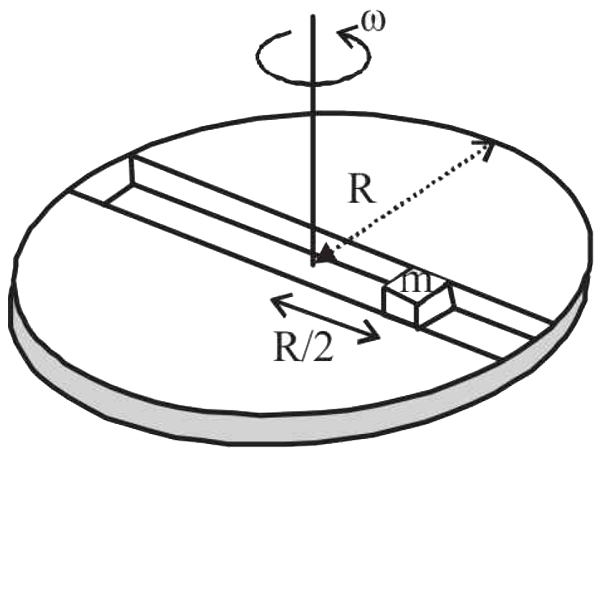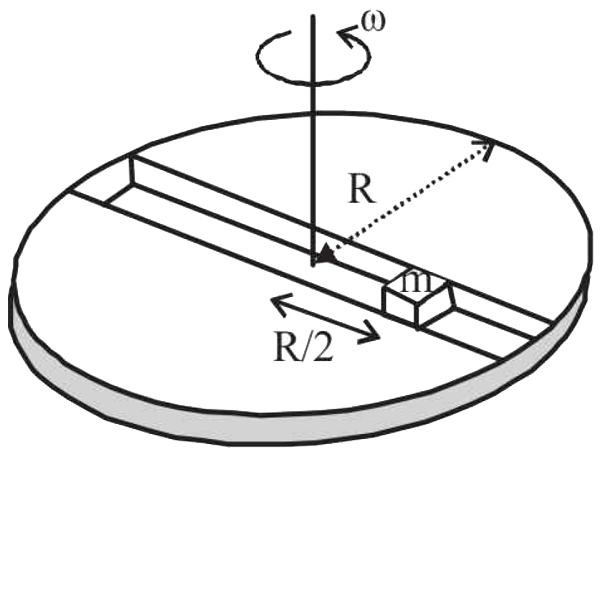A frame of reference that is accelerated with respect to an inertial frame of reference is called a non-inertial frame of reference. A coordinate system fixed on a circular disc rotating about a fixed axis with a constant angular velocity ω is an example of non=inertial frame of reference. The relationship between the force →Frot experienced by a particle of mass m moving on the rotating disc and the force →F∈ experienced by the particle in an inertial frame of reference is
→Frot=→Fin+2m(→vrot×→ω)+m(→ω×→r)×→ω.
where →vrot is the velocity of the particle in the rotating frame of reference and →r is the position vector of the particle with respect to the centre of the disc.
Now consider a smooth slot along a diameter fo a disc of radius R rotating counter-clockwise with a constant angular speed ω about its vertical axis through its center. We assign a coordinate system with the origin at the center of the disc, the x-axis along the slot, the y-axis perpendicular to the slot and the z-axis along the rotation axis (→ω=ωˆk). A small block of mass m is gently placed in the slot at →r(R/2)ˆi at t=0 and is constrained to move only along the slot.

The distance r of the block at time is
A
R2cos2ωt
B
R2cosωt
C
R4(eωt+e−ωt)
D
R4(e2ωt+e−2ωt)
Video Solution
Text Solution
The correct Answer is:C

Let →v be the velocity of block at a distance r from the axis .
Now , →Fin=0,→vrot=vˆi
→r=rˆi,→ω=ωˆk
Now , (→vrot×→ω)=vω(ˆi׈k)=−vωˆj
(→ω×→r)×→ω=ω2rˆi
∴ →Frot=−2mvωˆj+mω2rˆj
Now considering motion along x - axis
mdvdt=mω2r
mvdvdr=mω2r
∫v0∫vdv=∫rr0ω2rdr
v2r=ω2(r2−r20)2
⇒ v2=ω2(r2−r20)
⇒ v=ω√r2−r20
⇒drdt=ω√r2−r20
⇒∫dr√r2−r20=∫ωdt
put r=r0 sec θ
∴ dr=r0secθtanθdθ
⇒ ∫r0secθtanθdθ√r20sec2θ−r20=∫ωdt
⇒∫secθdω=∫ωdt
In (secθ+tanθ)=ωt+C
at t = 0 , θ=0
⇒C=0
⇒In(secθ+tanθ)=ωt
⇒secθ+tanθ=eωt ....(i)
using the identify
sec2θ−tan2θ=1
secθ−tanθ=e−ωt .....(ii)
from Eqns . (i) and (ii)
secθ=12(eωt+e−ωt)
⇒ rr0=12[eωt+e−ωt]
⇒ r=r02{eωt+e−ωt}
⇒ r=−R4[eωt+e−ωt]
|
Topper's Solved these Questions
- FRICTION AND CIRCULAR MOTION BOOK - GRB PUBLICATIONCHAPTER - FRICTION AND CIRCULAR MOTION EXERCISE - Integer answer
20 Videos
- FORCE AND NEWTONS LAWS OF MOTIONBOOK - GRB PUBLICATIONCHAPTER - FORCE AND NEWTONS LAWS OF MOTIONEXERCISE - Comprehension
12 Videos
- MOTION IN A STRAIGHT LINEBOOK - GRB PUBLICATIONCHAPTER - MOTION IN A STRAIGHT LINEEXERCISE - Comprehension type Queston
14 Videos
Similar Questions
Knowledge Check
A frame of reference that is accelerated with respect to an inertial frame of reference is called a non-inertial frame of reference. A coordinate system fixed on a circular disc rotating about a fixed axis with a constant angular velocity ω is an example of non=inertial frame of reference. The relationship between the force →Frot experienced by a particle of mass m moving on the rotating disc and the force →F∈ experienced by the particle in an inertial frame of reference is
→Frot=→Fin+2m(→vrot×→ω)+m(→ω×→r)×→ω.
where →vrot is the velocity of the particle in the rotating frame of reference and →r is the position vector of the particle with respect to the centre of the disc.
Now consider a smooth slot along a diameter fo a disc of radius R rotating counter-clockwise with a constant angular speed ω about its vertical axis through its center. We assign a coordinate system with the origin at the center of the disc, the x-axis along the slot, the y-axis perpendicular to the slot and the z-axis along the rotation axis (→ω=ωˆk). A small block of mass m is gently placed in the slot at →r(R/2)ˆi at t=0 and is constrained to move only along the slot.

The net reaction of the disc on the block isA(a) 12mω2R(e2ωt−e−2ωt)ˆj+mgˆkB(b) 12mω2R(eωt−e−ωt)ˆj+mgˆkC(c) −mω2Rcosωtˆj−mgˆkD(d) mω2Rsinωˆj−mgˆkNon-inertial frame of reference have
Azero acceleration.Bsome acceleration with respect to inertial frame of reference.Czero velocity.Dconstant velocity with respect to inertial frame of reference.An inertial frame of reference is, by definition,
Aa frame moving with uniform velocity w.r.t. earthBa frame moving with velocity w.r.t our SunCa frame which is not rotatingDa frame in which Newton's first law of motion is valid.
